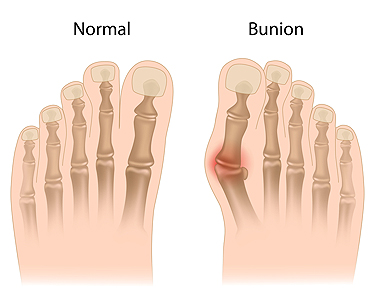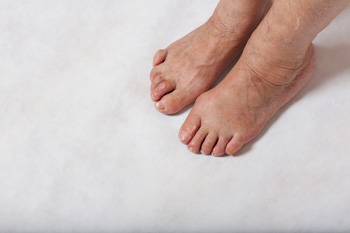Connect With Us
Blog
Items filtered by date: April 2025
Simple Exercises That May Help Ease Bunion Discomfort

Bunions can cause pain, stiffness, and swelling near the big toe joint. While bunions do not go away on their own, gentle exercises may help reduce discomfort, improve flexibility, and slow their progression. One helpful move is the toe stretch where you simply pull the big toe gently into alignment and hold for several seconds. Another is the towel scrunch. This involves placing a towel flat on the floor and using your toes to scrunch it toward you, which can strengthen the foot muscles. Try toe spreading by placing small spacers or your fingers between your toes and holding for a short time. Additionally, rolling a ball under your foot can also ease tension. These exercises should be done daily and combined with supportive shoes and foot care. If you have bunion pain, it is suggested that you see a podiatrist for appropriate treatment.
If you are suffering from bunion pain, contact Jeffrey Rosenblatt, DPM of New York. Our doctor can provide the care you need to keep you pain-free and on your feet.
What Is a Bunion?
Bunions are painful bony bumps that usually develop on the inside of the foot at the joint of the big toe. As the deformity increases over time, it may become painful to walk and wear shoes. Women are more likely to exacerbate existing bunions since they often wear tight, narrow shoes that shift their toes together. Bunion pain can be relieved by wearing wider shoes with enough room for the toes.
Causes
- Genetics – some people inherit feet that are more prone to bunion development
- Inflammatory Conditions - rheumatoid arthritis and polio may cause bunion development
Symptoms
- Redness and inflammation
- Pain and tenderness
- Callus or corns on the bump
- Restricted motion in the big toe
In order to diagnose your bunion, your podiatrist may ask about your medical history, symptoms, and general health. Your doctor might also order an x-ray to take a closer look at your feet. Nonsurgical treatment options include orthotics, padding, icing, changes in footwear, and medication. If nonsurgical treatments don’t alleviate your bunion pain, surgery may be necessary.
If you have any questions, please feel free to contact our office located in Brooklyn, NY . We offer the newest diagnostic and treatment technologies for all your foot care needs.
Understanding Diabetic Ankle Fractures

People with diabetes are at a higher risk for ankle fractures due to weakened bones and reduced sensation in the feet and ankles. Neuropathy can make it difficult to feel injuries, which may lead to delayed diagnosis and treatment. Poor circulation and slower healing times also increase the risk of complications. Ankle fractures in diabetic patients can be more serious than in the general population. If not treated promptly, they can lead to infections, non-healing fractures, or even Charcot foot, a condition where the bones weaken and collapse. A podiatrist can provide a thorough evaluation and recommend the appropriate treatment, which may include immobilization, surgery, or custom orthotics. If you have diabetes and experience ankle pain, swelling, or difficulty walking, it is suggested you schedule an appointment with a podiatrist who can provide a thorough evaluation and recommend the appropriate treatment, which may include immobilization, surgery, or custom orthotics.
Diabetic foot care is important in preventing foot ailments such as ulcers. If you are suffering from diabetes or have any other concerns about your feet, contact Jeffrey Rosenblatt, DPM from New York. Our doctor can provide the care you need to keep you pain-free and on your feet.
Diabetic Foot Care
Diabetes affects millions of people every year. The condition can damage blood vessels in many parts of the body, especially the feet. Because of this, taking care of your feet is essential if you have diabetes, and having a podiatrist help monitor your foot health is highly recommended.
The Importance of Caring for Your Feet
- Routinely inspect your feet for bruises or sores.
- Wear socks that fit your feet comfortably.
- Wear comfortable shoes that provide adequate support.
Patients with diabetes should have their doctor monitor their blood levels, as blood sugar levels play such a huge role in diabetic care. Monitoring these levels on a regular basis is highly advised.
It is always best to inform your healthcare professional of any concerns you may have regarding your feet, especially for diabetic patients. Early treatment and routine foot examinations are keys to maintaining proper health, especially because severe complications can arise if proper treatment is not applied.
If you have any questions please feel free to contact our office located in Brooklyn, NY . We offer the newest diagnostic and treatment technologies for all your foot and ankle needs.
It's Time for Beautiful Feet
Implant Options for Rigid Hammertoe

When it comes to correcting rigid hammertoe deformities, surgery often includes the use of implants to help straighten and stabilize the toe. One important decision in this process is whether to use a permanent implant or one that can be removed later. Permanent implants are designed to stay in place indefinitely, providing long-term support and alignment. They are often chosen for their durability and the convenience of not requiring a second procedure for removal. Removable implants offer flexibility. Once the toe has healed in the proper position, these implants can be taken out, leaving the body free of foreign materials. The choice between permanent and removable implants depends on several factors, including the severity of the deformity, the patient’s lifestyle, and overall health. If you have a painful rigid hammertoe, it is suggested that you obtain a personalized consultation with a podiatrist who will help you determine the most appropriate solution for its correction
Hammertoe
Hammertoes can be a painful condition to live with. For more information, contact Jeffrey Rosenblatt, DPM from New York. Our doctor will answer any of your foot- and ankle-related questions.
Hammertoe is a foot deformity that affects the joints of the second, third, fourth, or fifth toes of your feet. It is a painful foot condition in which these toes curl and arch up, which can often lead to pain when wearing footwear.
Symptoms
- Pain in the affected toes
- Development of corns or calluses due to friction
- Inflammation
- Redness
- Contracture of the toes
Causes
Genetics – People who are genetically predisposed to hammertoe are often more susceptible
Arthritis – Because arthritis affects the joints in your toes, further deformities stemming from arthritis can occur
Trauma – Direct trauma to the toes could potentially lead to hammertoe
Ill-fitting shoes – Undue pressure on the front of the toes from ill-fitting shoes can potentially lead to the development of hammertoe
Treatment
Orthotics – Custom made inserts can be used to help relieve pressure placed on the toes and therefore relieve some of the pain associated with it
Medications – Oral medications such as anti-inflammatories or NSAIDs could be used to treat the pain and inflammation hammertoes causes. Injections of corticosteroids are also sometimes used
Surgery – In more severe cases where the hammertoes have become more rigid, foot surgery is a potential option
If you have any questions please contact our office located in Brooklyn, NY . We offer the newest diagnostic and treatment technologies for all your foot and ankle needs.
Blog Archives
- April 2025
- March 2025
- February 2025
- January 2025
- December 2024
- November 2024
- October 2024
- September 2024
- August 2024
- July 2024
- June 2024
- May 2024
- April 2024
- March 2024
- February 2024
- January 2024
- December 2023
- November 2023
- October 2023
- September 2023
- August 2023
- July 2023
- June 2023
- May 2023
- April 2023
- March 2023
- February 2023
- January 2023
- December 2022
- November 2022
- October 2022
- September 2022
- August 2022

